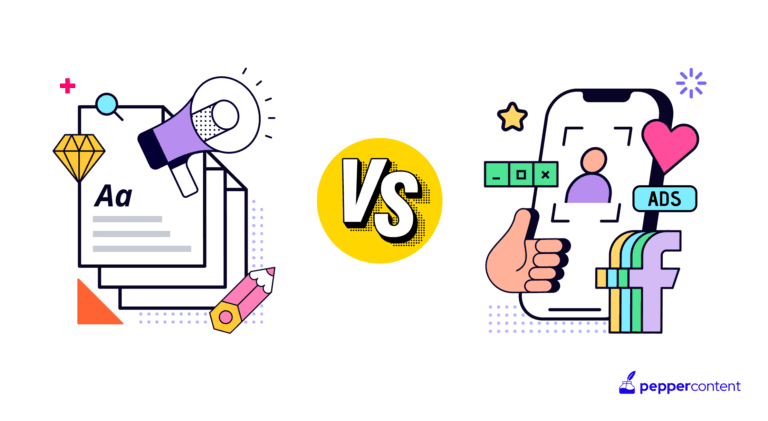Content Matrix: What Is it and Why Is it Beneficial to Your Business

A content matrix is a marketer’s visual map to understand a brand’s user personas and then use that knowledge to create impactful content. It helps you position and market the right content in the right place at the right time.
The image below shows a content matrix example that divides content assets as per priority (left to right) and categorizes them as per intent (top to bottom).

For awareness, assets like competitions for the user and data visualization for the market come into play. Whereas to maintain consumer loyalty to the brand, several tactics such as producing podcasts, webinars, and events are recommended to be deployed.
Before we study how to create a content matrix for your brand, let’s first look at the benefits of this exercise for a business.

How Is a Content Matrix Helpful to Your Business?
Here’s what the content matrix does for your brand:
● It helps your company prioritize content production so that your team can focus on producing content that is the need of the hour.
● It helps you organize content based on where it falls in the conversion funnel. This is helpful when mapping the user journeys of your personas on your website. Because it helps you target content factors that matter to a buyer when they are on the website, trying to do their research or buy your product.
● It helps you recognize the most effective tactics to reach your target audience.
● It helps you produce a detailed, high-level marketing strategy and guides you to its execution.
The content matrix example below is a foundational template used across businesses. It encourages marketers to divide content according to its effect on a user. Whether it would entertain them, inspire them towards your genre, educate them about the field, or convince them to buy your service/product.

With this basic knowledge of the content matrix, let’s explore the correct steps that will lead you to build the most impactful content matrix for your business.
Creating a Content Matrix: Step By Step Guide
Step 1: Build personas of the user/buyer
Start by understanding the set of people that are most likely to buy your product or service. While imagining these individuals, you can list their age, gender, job title or income group, basic wants and needs, goals, hobbies, and motivations in life.

If you wish to go more in-depth, figure out what or who influences them (both online and offline), how they choose to make their purchases, and when they are most likely to make that purchase.
This information can help you determine what you need to market, categorize your products or services as per the different user personas, and align content on your website or social media channels as per your learnings.
Note that most businesses have at least two to three types of customers, so your brand should have more than one type of buyer persona.

Step 2: Map out the buyer’s journey
If you have an online shop, the next step is to understand the user journey on your website. Start looking at the pages on your website from the point of view of your different user personas. Then:
● Identify the challenges a buyer may face as per your site’s current content placement.
● Map out solutions such as adding a piece of information somewhere or recommending similar products somewhere else.
● Organize all your existing content as per the most probable buyer journey maps that you figured in the content matrix.
Step 3: Define content priorities
Does your business need a dedicated blog more than a podcast right now? Will ebooks help you reach more people? Recognize the best content assets for your brand and make a chart marking their priority and need for your content matrix strategy.
You can refer to the following content assets and choose the best ones for your business:
● Brochures
● Infographics
● Articles
● Blog Posts
● Podcasts
● Webinars
● Presentations
● Newsletters
● Case Studies
● Testimonials
● ebooks
● Videos
● Datasheets
● Website Pages
At this step, you must also focus on updating all outdated content as per your content matrix.

Step 4: Make a plan for content production
Now that you know your buyer’s probable personas and have defined your content priorities, it is time to form a content strategy that leverages this information to your brand’s benefit.
Further, prioritize each content asset, align resources, and research how you can get started with each asset listed in the content matrix.
While making a plan, it is pivotal to recognize your business’s overlying intent and goal. For example, do you need more footfall on the website? Do you want more people to recognize your business? Or do you want to grow your social media and so on.
Step 5: Keep updating your content matrix
Once you have the ball rolling and all the gears are under check, the next step is to keep your content matrix relevant. Keep adding more marketing assets to your content matrix as you grow your marketing and business. Then, strategize focused plans for marketing them in line with your already existing assets.
For example, once you have successfully marketed to your audience on Twitter for a few months, you might want to consider Linkedin marketing alongside.
This way, keep adding more marketing assets to reach a wider audience every few months. And with that, keep auditing and reorganizing content on your website. This will help you stay on top of the user journey and conversions.
Conclusion
Now that you know how to create the content matrix that organizes your brand’s goals, you are ready to take the journey of prioritizing, dismissing, and creating compelling content.
Build at least three user personas that you can refer to while defining the most effective matrix content for your website and marketing channels.
FAQs
A matrix that helps you funnel your marketing as per your business’s specific goals is called a content marketing matrix. It can be built by assessing the feeling you wish to stir in your consumer through your content.
Analyze whether you want to entertain, inspire, educate, or convince your audience as the foundational step to creating your company’s content marketing matrix.
Metalogix Content Matrix by Quest is an effective tool to start your journey into making matrix content. However, a trusted template for designing the content matrix comes in more handy than any tool in practical usage.
This is because content matrices are detailed and highly specific to your nature of business. Thus, you can rely on an accurate content matrix template instead of a tool.
A website content matrix is a strategy that helps you make the layout and content placement on every single step of a buyer’s journey fruitful.
For designing a website content matrix, one needs a clear understanding of the different user personas of the business.
Then, marketers can place important buttons and communication for a smoother user journey on the website by recognizing where they are likely to click next and the subsequent journey.
Latest Blogs
In this blog, explore the golden rules of using AI marketing tools so you can leverage the benefits to their maximum potential.
In this blog, you’ll learn how to avoid the pitfalls of SEO over-optimization while enhancing your site’s performance.
In this article, we’ll take a look at what AMP is, its advantages and disadvantages, and how it affects SEO.
Get your hands on the latest news!
Similar Posts

Content
9 mins read
Content Marketing vs Advertising – Which One is More Effective?

Content
11 mins read
Interactive Content vs. Static Content: Which is More Effective?

Content
6 mins read